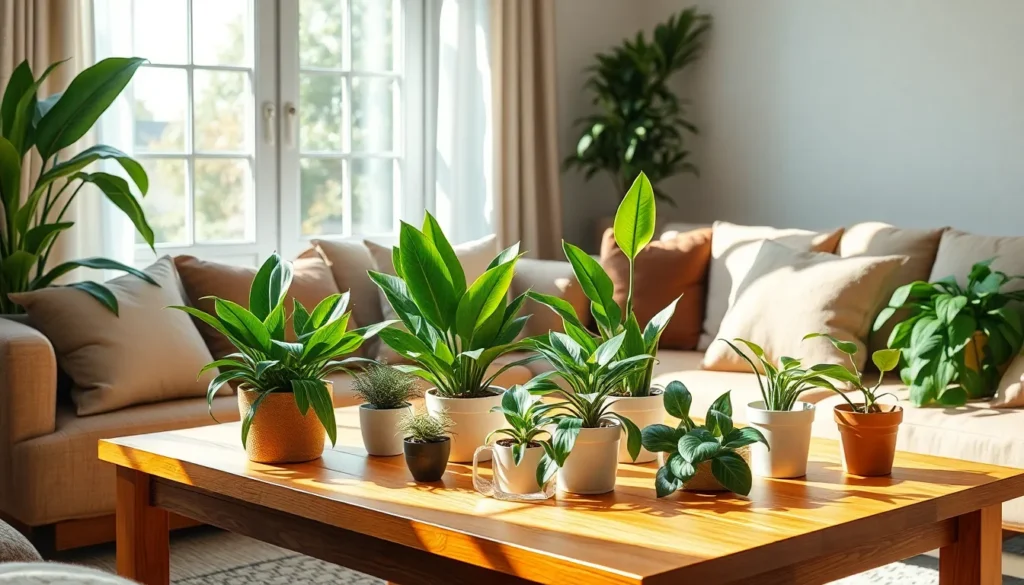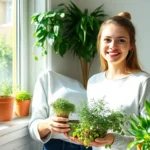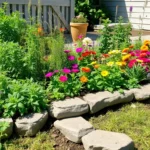We’ve all been there – staring at that dim corner of our living room wondering if we’ll ever be able to bring some greenery into our space. The good news? You don’t need a sun-drenched solarium to create your own indoor jungle. Low-light houseplants are game-changers for anyone dealing with north-facing windows, basement apartments, or those cozy spots that never seem to catch direct sunlight.
Forget everything you’ve heard about plants needing tons of bright light to thrive. We’re about to show you how dozens of stunning varieties actually prefer those shadier conditions. From glossy snake plants that practically ignore you to dramatic peace lilies that bloom in dim spaces, these resilient beauties will transform your home without demanding perfect lighting conditions.
Ready to discover which plants will flourish in your low-light sanctuary? Let’s jump into our carefully curated list of the most gorgeous and foolproof options that’ll make your space feel alive – no matter how little natural light you’re working with.
Snake Plant: The Ultimate Low-Light Survivor
Snake plants (Sansevieria trifasciata) stand as the perfect choice for anyone seeking resilient indoor greenery that thrives in dimly lit spaces. We’ve found these striking plants can tolerate extremely low light conditions while maintaining their architectural beauty and air-purifying qualities.
Watering Requirements and Care Tips
Watering frequency should remain minimal for snake plants, as these drought-tolerant specimens prefer their soil to dry completely between waterings. We recommend checking the soil moisture by inserting your finger 2-3 inches deep into the potting mix every 2-3 weeks during growing season.
Overwatering poses the biggest threat to snake plant health, often leading to root rot and yellowing leaves. During winter months, we suggest reducing watering frequency to once every 4-6 weeks since the plant’s growth slows significantly in lower temperatures and reduced daylight.
Well-draining potting soil works best for these low-maintenance plants, with a standard houseplant mix combined with perlite or coarse sand providing optimal drainage. We’ve noticed that terra cotta pots help wick away excess moisture more effectively than plastic containers.
Temperature stability between 65-80°F creates ideal growing conditions, though snake plants can tolerate temperature fluctuations better than most houseplants. Humidity levels don’t require special attention since these plants adapt well to typical indoor environments ranging from 30-50% relative humidity.
Best Placement Options for Maximum Growth
North-facing windows provide excellent placement for snake plants, offering consistent indirect light without the intensity that might cause leaf scorching. We’ve successfully grown healthy specimens in these locations with minimal additional care requirements.
Corner spaces away from direct sunlight work wonderfully for snake plants, making them perfect for offices, bedrooms, or hallways with limited natural light exposure. These plants can thrive in areas that receive as little as 2-4 hours of indirect sunlight daily.
Bathroom environments suit snake plants perfectly due to their tolerance for varying humidity levels and occasional low-light conditions. We recommend placing them near frosted windows or under skylights where they’ll receive filtered natural light.
Basement apartments and interior rooms present no challenge for snake plants, as they can survive and even grow slowly under artificial lighting conditions. Fluorescent or LED grow lights positioned 12-18 inches above the plant can supplement natural light when needed.
Distance from heating vents and air conditioning units should be maintained to prevent sudden temperature changes that might stress the plant. We suggest keeping snake plants at least 3-4 feet away from direct airflow sources while ensuring adequate air circulation around the foliage.
ZZ Plant: Glossy Leaves That Thrive in Darkness
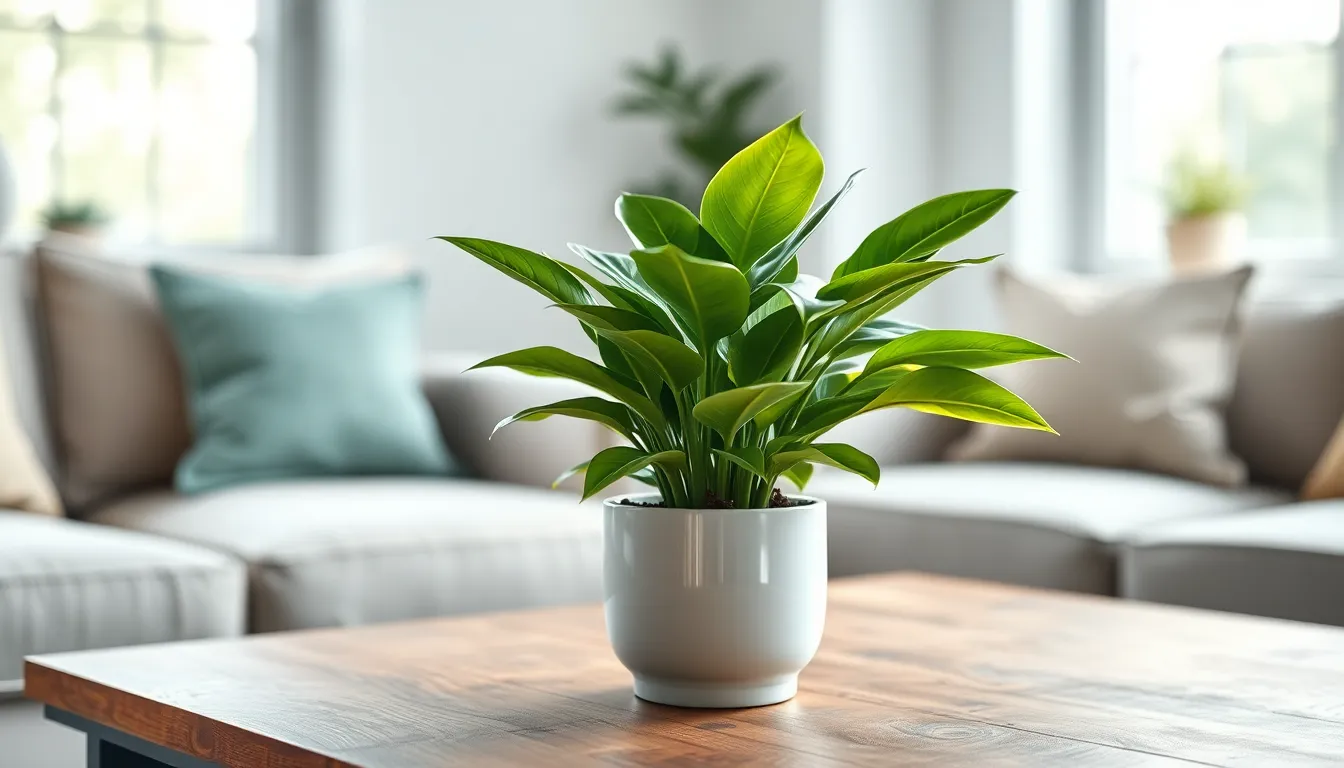
The ZZ Plant (Zamioculcas zamiifolia) stands out as another exceptional choice for transforming your dim spaces into vibrant green sanctuaries. We’ve found this resilient beauty to be remarkably adaptable to low light conditions while maintaining its stunning glossy foliage.
Why ZZ Plants Are Perfect for Beginners
Exceptionally low maintenance requirements make the ZZ Plant ideal for those just starting their indoor gardening journey. We appreciate how this plant tolerates neglect better than most houseplants, requiring watering only every 2-3 weeks in most conditions.
Glossy leaves create an attractive focal point in any room while requiring minimal care to maintain their lustrous appearance. The waxy coating on each leaf naturally repels dust and maintains shine without frequent cleaning.
Drought tolerance allows ZZ Plants to thrive even when we forget to water them regularly. These plants store water in their thick stems and roots, making them particularly beneficial for busy schedules or frequent travelers.
Adaptability to various lighting conditions means we can place ZZ Plants in offices, bedrooms, or any space with limited natural light. They’ll continue growing steadily even in artificial lighting environments.
Air purifying qualities provide an additional benefit beyond their aesthetic appeal. NASA studies show ZZ Plants effectively remove toxins like xylene and toluene from indoor air.
Propagation Methods for Expanding Your Collection
Division propagation works best for mature ZZ Plants with multiple stems growing from the base. We recommend carefully separating the root ball into sections, ensuring each division has both roots and stems attached.
Stem cutting propagation offers another reliable method for creating new plants from your existing ZZ Plant. Cut healthy stems at soil level and place them in water or well draining potting mix until roots develop over 4-6 weeks.
Leaf cutting propagation provides the most economical way to multiply your collection, though it requires patience. Individual leaves can be planted in soil and will eventually develop into new plants over several months.
Rhizome division allows us to propagate directly from the underground root system during repotting. Each rhizome section with growing points can become an independent plant when properly cared for.
Pothos: Trailing Beauty for Dim Corners
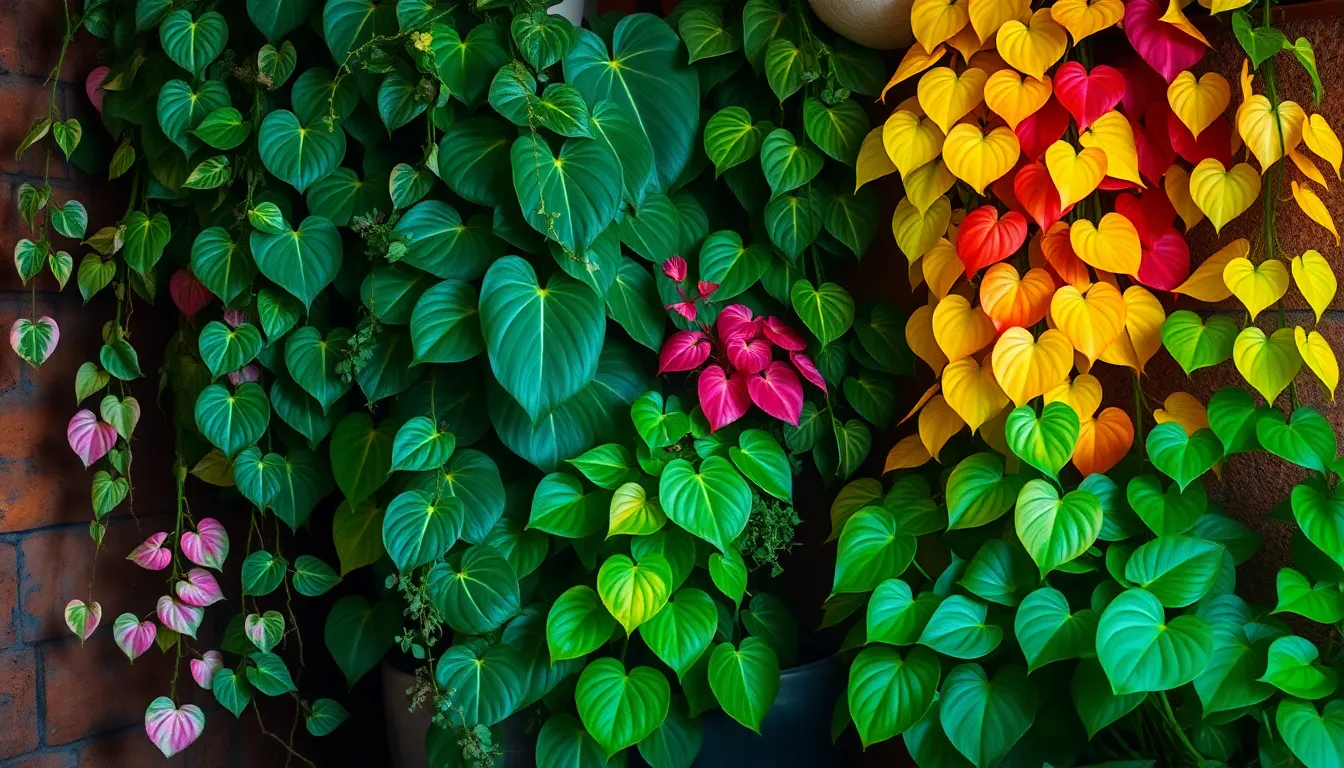
We’ve found that pothos stands out as one of the most versatile trailing plants for dim indoor spaces. These adaptable vines bring cascading greenery to corners where other plants might struggle to survive.
Different Pothos Varieties for Indoor Spaces
Marble Queen pothos offers stunning variegated leaves with a beautiful mix of green and white colors that brighten any low light corner. This variety maintains its striking leaf patterns even in minimal lighting conditions.
Neon pothos provides vibrant chartreuse colored foliage that adds a pop of bright color to darker spaces. We recommend this variety for areas that need an instant energy boost without requiring bright sunlight.
Manjula pothos features distinctive heart shaped leaves with intricate marbled patterns across each leaf surface. These unique markings create visual interest and texture that makes this variety particularly appealing for decorative displays.
Golden pothos remains the classic choice with its glossy green leaves highlighted by golden yellow variegation. This traditional variety adapts exceptionally well to various lighting conditions while maintaining consistent growth patterns.
Training and Pruning Techniques
Pruning your pothos regularly helps maintain the desired shape while promoting healthier and bushier growth throughout the plant. We suggest trimming long vines back to encourage new growth from the base and prevent the plant from becoming too leggy.
Training techniques involve using trellises or stakes to guide your pothos in exact directions for optimal visual impact. You can encourage vertical climbing by providing moss poles or wooden stakes for the aerial roots to grip onto.
Pinching growing tips stimulates branching and creates fuller, more compact growth patterns instead of long trailing stems. This technique works particularly well when you want a bushier appearance rather than lengthy cascading vines.
Propagating cuttings from your pruning sessions allows you to create new plants while maintaining the parent plant’s health and appearance. Simply place 4 to 6 inch stem cuttings in water until roots develop before transplanting into soil.
Peace Lily: Elegant Blooms in Low-Light Conditions
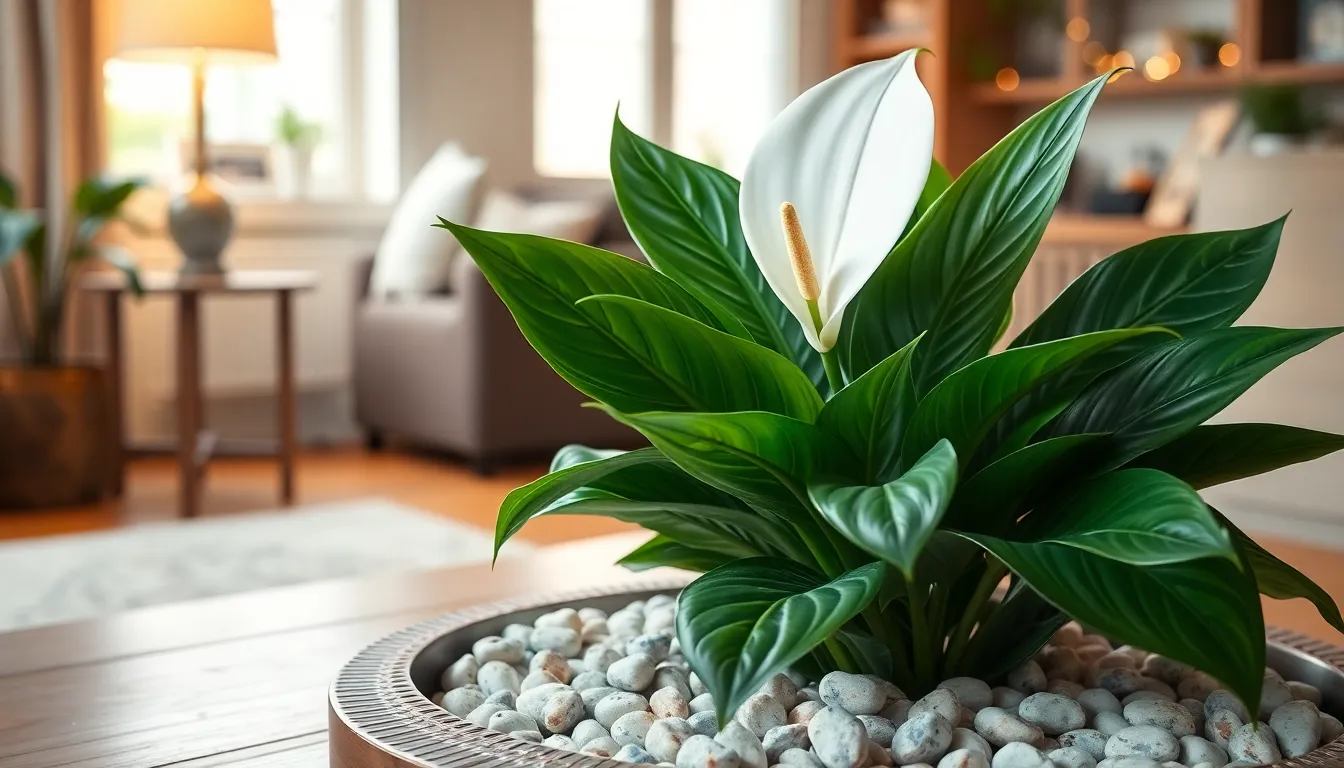
Peace lilies bring sophisticated elegance to dim indoor spaces with their stunning white blooms and glossy green foliage. We’ve found these air-purifying plants thrive in partial shade conditions, making them perfect companions to our other low-light favorites.
Signs Your Peace Lily Needs Attention
Wilting leaves indicate your peace lily isn’t receiving adequate water or humidity levels. We notice this dramatic drooping typically occurs when the soil becomes too dry or when indoor air lacks sufficient moisture.
Yellow leaves often signal overwatering issues in peace lily care. Too much water causes root problems and nutrient absorption difficulties, leading to that telltale yellowing we want to avoid.
Missing blooms suggest your peace lily lacks proper light or essential nutrients. While these plants tolerate low light well, they still need some indirect sunlight to produce their signature white flowers.
Brown leaf tips commonly appear when humidity drops below optimal levels. We see this frequently in winter months when heating systems reduce indoor moisture significantly.
Creating Optimal Humidity Levels
Peace lilies prefer humidity levels between 40% to 60% relative humidity for optimal growth and blooming. We achieve this by placing plants on trays filled with water and pebbles, which creates a localized humid microclimate.
Humidifier placement near your peace lily provides consistent moisture levels throughout the day. Position the device within 3 to 4 feet of your plant for maximum effectiveness.
Grouping plants together naturally increases humidity through transpiration. We cluster our peace lilies with other houseplants to create beneficial moisture zones.
Misting techniques can supplement humidity when done correctly. Spray around the plant rather than directly on leaves to prevent fungal issues while maintaining proper moisture levels.
Bathroom placement works exceptionally well for peace lilies due to naturally higher humidity from showers and baths. These low-light conditions combined with steam create ideal growing environments.
Chinese Evergreen: Colorful Foliage Without Bright Light
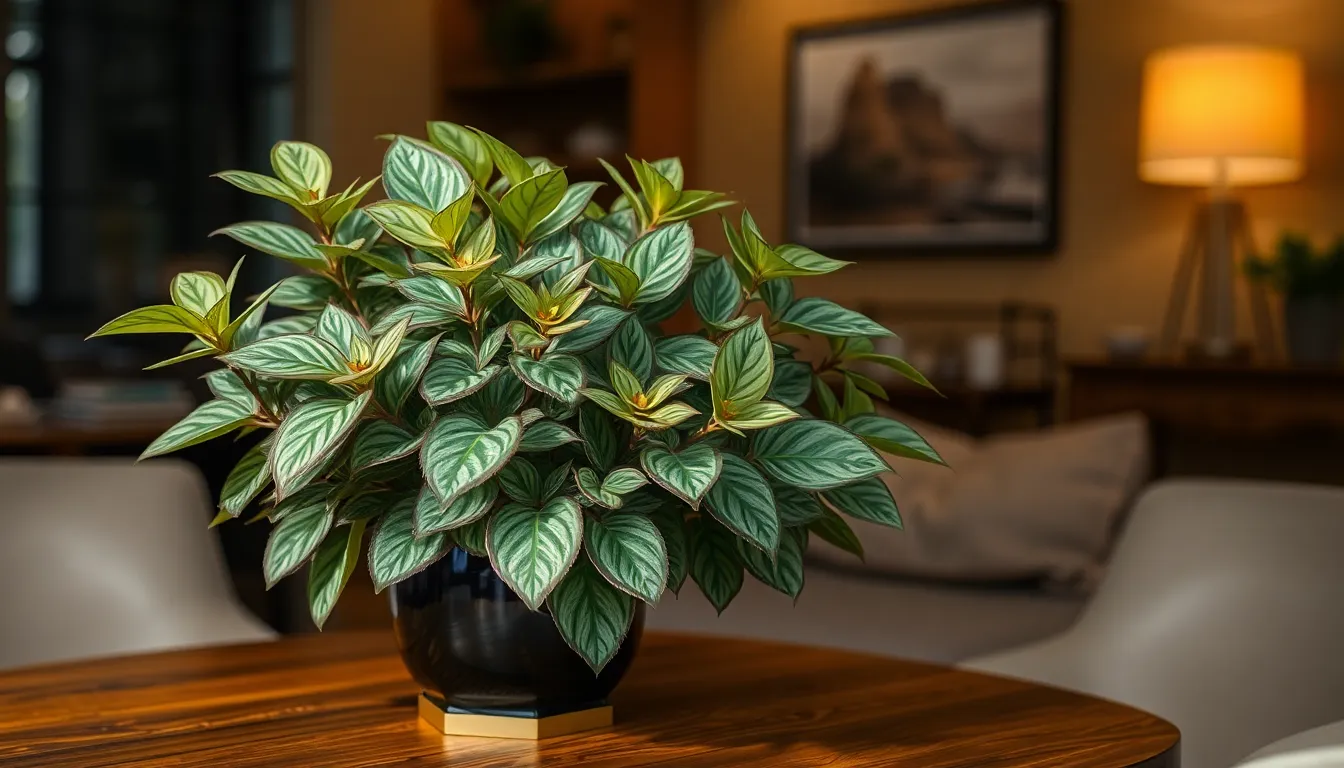
Chinese Evergreen plants stand out for their ability to thrive in low to bright indirect light conditions, making them perfect additions to our dim indoor spaces. These adaptable plants offer stunning colored foliage without requiring the bright light that many houseplants demand.
Popular Chinese Evergreen Cultivars
Algaonema ‘White Joy’ captures attention with its beautiful white variegation that creates striking patterns across each leaf. This cultivar maintains its elegant appearance even in lower light conditions.
Algaonema ‘Silver Queen’ features sophisticated silver markings that dance across its dark green foliage. The contrast between the metallic silver and deep green creates a luxurious appearance that elevates any room’s aesthetic.
Algaonema ‘Silver Bay’ offers lovely silver-green foliage that provides a softer, more subtle appearance than its bolder counterparts. This variety works particularly well in spaces where we want understated elegance.
Varieties with more colored foliage may require slightly brighter conditions to maintain their vibrant appearance, though they’ll still adapt well to most indoor lighting situations.
Common Problems and Answers
Leaf browning typically indicates exposure to cold temperatures or drafts that stress the plant. We can solve this issue by moving our Chinese Evergreen to a warmer, draft-free area away from air conditioning vents or cold windows.
Lack of color occurs when plants receive insufficient light to maintain their characteristic variegation. Providing slightly brighter indirect light helps enhance color definition and brings back the plant’s natural vibrancy.
Watering issues commonly manifest as root rot from overwatering these moisture-sensitive plants. We should water until water comes out of drainage holes, then allow the soil to dry completely between waterings to prevent root damage.
Temperature fluctuations can also cause stress, so maintaining consistent indoor temperatures between 65-80°F helps our Chinese Evergreen plants flourish with their characteristic colorful foliage intact.
Cast Iron Plant: Victorian Era Resilience for Modern Homes
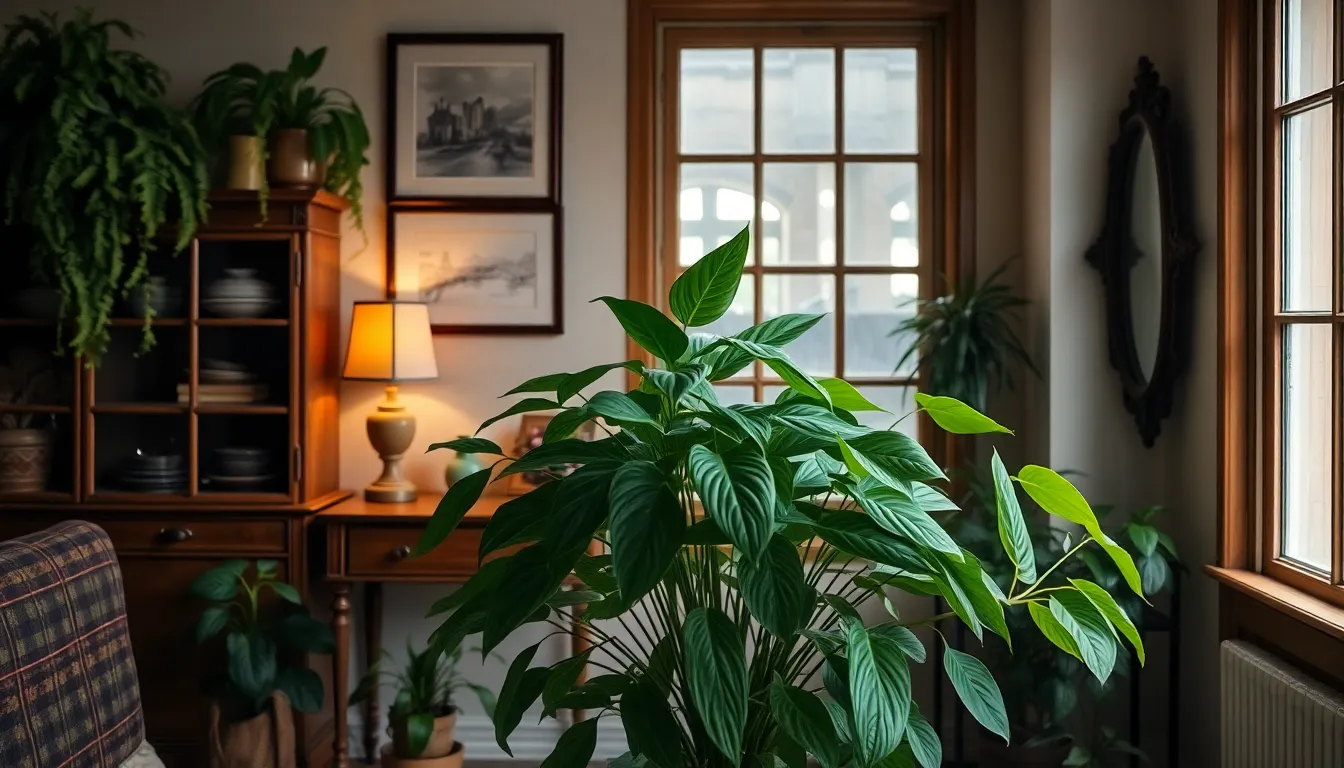
The Cast Iron Plant (Aspidistra elatior) stands as one of the most durable low light houseplants we can grow indoors. This remarkable plant earned its reputation during the Victorian era when it became the go-to choice for dimly lit parlors and coal-heated homes.
Historical Background and Popularity
Victorian homes presented unique challenges for indoor plants, with gas lighting and coal fires creating harsh conditions that few plants could survive. The Cast Iron Plant emerged as the perfect solution, thriving in the dark corners and neglected spaces of 19th-century households. Its ability to withstand extreme neglect made it a symbol of resilience during this period.
Popularity soared throughout the Victorian era as homeowners discovered this plant’s exceptional tolerance for low light conditions. Modern gardeners continue to appreciate these same qualities, making the Cast Iron Plant a favorite choice for contemporary homes with limited natural light. We often recommend this plant to beginners because it forgives nearly every common houseplant mistake.
The plant’s common name perfectly captures its durability, as it can survive conditions that would kill most other houseplants. Victorian gardeners often joked that you could grow this plant in a closet, and modern research confirms that Cast Iron Plants can indeed thrive in extremely low light environments where other plants would struggle to survive.
Seasonal Care Adjustments
Winter care requires important adjustments to our watering schedule, as Cast Iron Plants need dramatically less water during colder months. We reduce watering frequency from every 2-3 weeks to every 4-6 weeks, allowing the soil to dry completely between waterings. Temperature stability becomes crucial during winter, so we keep these plants away from drafty windows and heating vents.
Summer adjustments focus on slightly increased watering frequency if the plant sits in a warmer location within our homes. We monitor soil moisture more carefully during hot weather, watering when the top 2-3 inches feel dry to the touch. But, we must ensure the soil never remains constantly moist, as this can lead to root rot even in these resilient plants.
Humidity management varies by season, with winter’s dry indoor air requiring occasional misting or placement near a humidity tray. During summer months, we typically find that normal household humidity levels provide adequate moisture for healthy growth. We also rotate our Cast Iron Plants quarterly to ensure even growth and prevent one-sided development throughout the changing seasons.
Philodendron: Heart-Shaped Leaves for Shady Spots
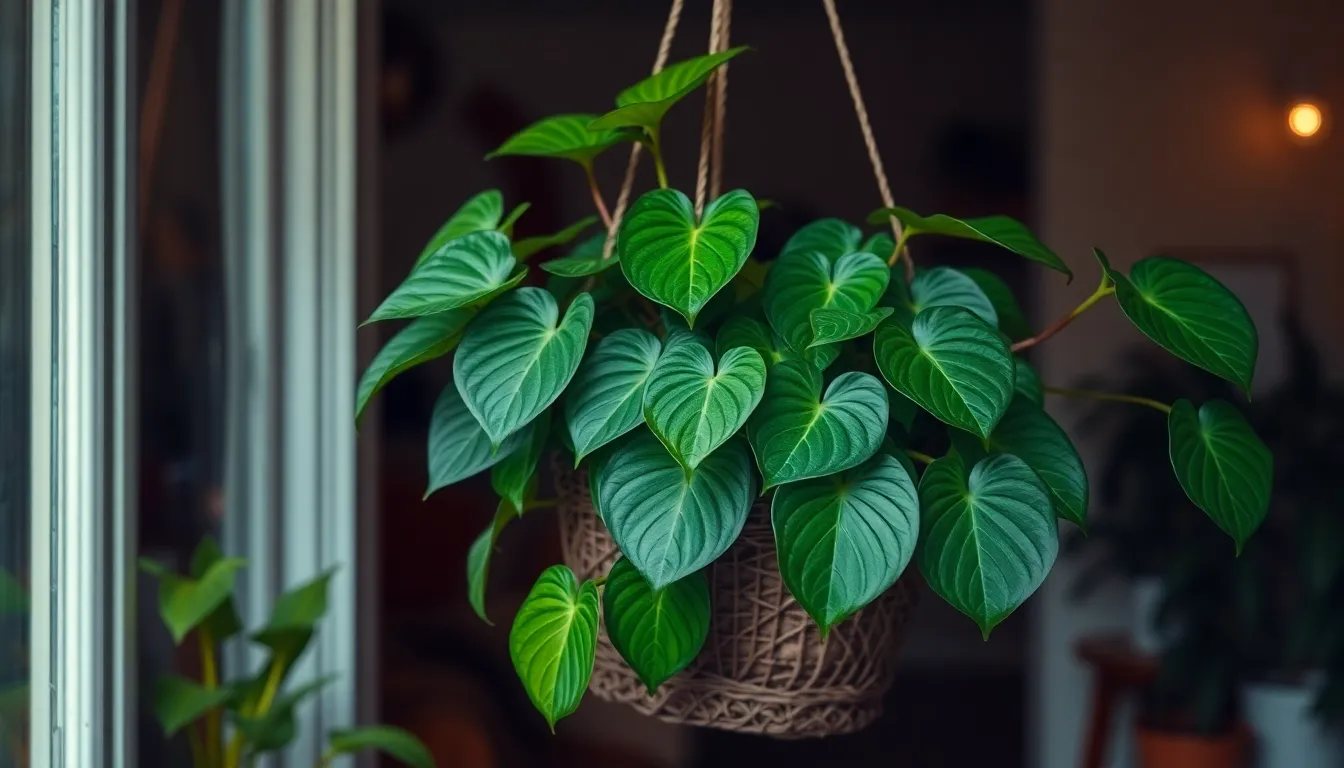
We’ve found philodendrons to be among the most reliable choices for low-light indoor spaces, thanks to their distinctive heart-shaped leaves and remarkable adaptability to dim conditions.
Climbing vs. Non-Climbing Varieties
Climbing philodendrons offer incredible versatility with their long, trailing vines that can transform any space. Philodendron hederaceum, commonly known as the Heartleaf Philodendron, excels in low to medium light conditions while producing cascading foliage that’s perfect for hanging baskets or training up moss poles. These vining varieties adapt beautifully to various display options, whether you want them spilling from high shelves or climbing decorative supports.
Non-climbing philodendrons create stunning focal points with their compact, bushy growth patterns. Varieties like Philodendron ‘Brasil’ and Philodendron ‘Moonlight’ form self-heading plants that stay relatively contained while still tolerating low light conditions. Growth rates tend to be slower in dimmer environments, but these plants maintain their attractive form and remain smaller than their climbing relatives.
Both types provide excellent air-purifying benefits, making them practical additions to offices, hallways, and north-facing rooms where natural light is limited.
Repotting and Root Care
Timing your repotting becomes crucial when roots start growing through drainage holes or soil dries out rapidly after watering. We recommend checking philodendrons every 1-2 years for signs they’ve outgrown their current containers.
Root inspection during repotting helps prevent future problems with rot and poor drainage. Gently loosen any tightly coiled roots and remove dead or mushy sections using clean scissors. Well-draining potting mix prevents waterlogged conditions that can damage healthy root systems.
Container selection should provide room for growth without overwhelming the plant. Choose pots 1-2 inches larger in diameter than the current container to allow adequate space for root expansion.
Post-repotting care requires thorough watering followed by complete drainage of excess water. Keep your newly repotted philodendron in its usual low-light location and avoid direct sunlight, which can scorch leaves during this adjustment period.
Dracaena: Architectural Appeal in Low-Light Settings
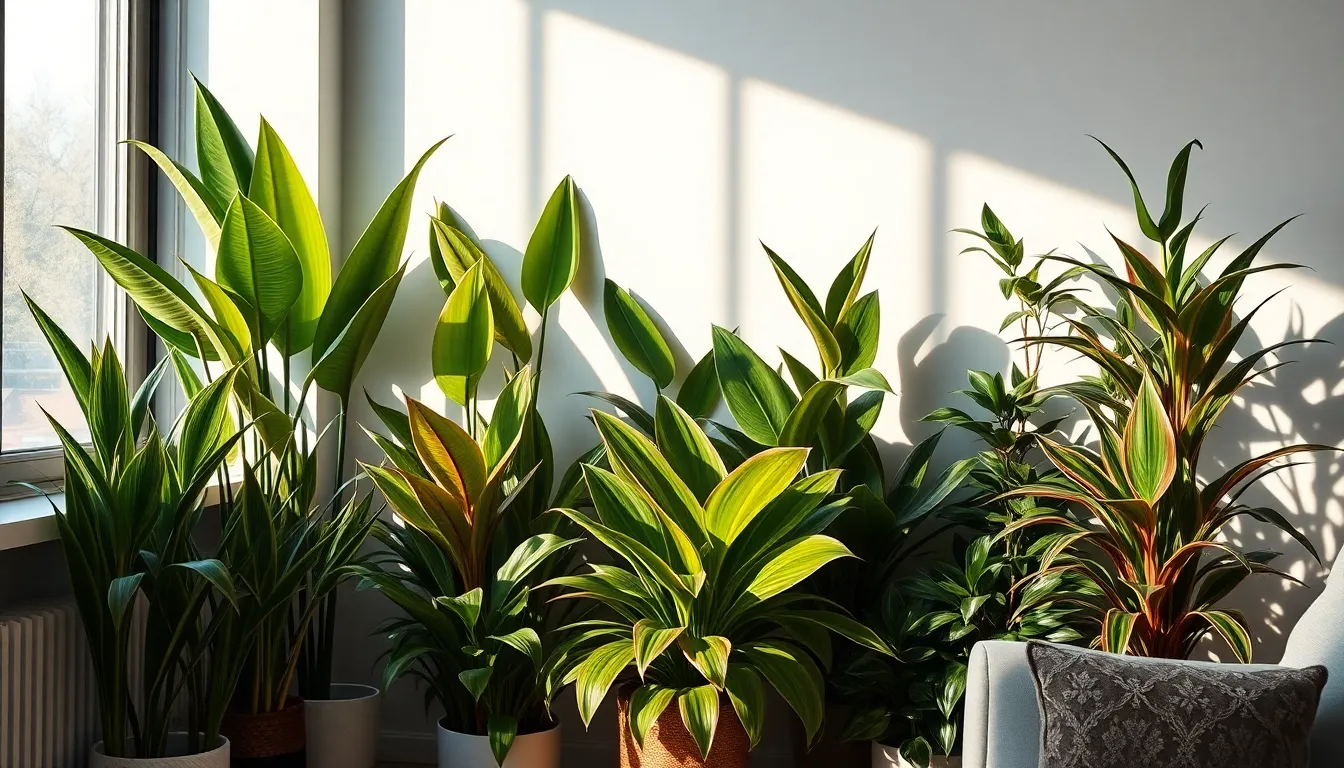
Dracaena stands out as one of the most versatile houseplants for creating dramatic visual impact in dimly lit spaces. These striking plants bring sculptural beauty to any room while adapting exceptionally well to low-light conditions.
Different Dracaena Species for Indoor Growing
Dracaena marginata offers slender, sword-like leaves with distinctive red edges that create an elegant silhouette in corner spaces. Growing tall and narrow, this species works perfectly in areas with limited floor space while adding vertical interest to your indoor garden.
Dracaena fragrans provides broader leaves and occasionally produces fragrant white flowers that fill rooms with a sweet scent. This variety excels at air purification, making it ideal for bedrooms and living areas where you want both beauty and cleaner air.
Dracaena reflexa features twisted, spiraling leaves that add unique texture to your plant collection. We find this variety particularly striking when placed near north-facing windows where its unusual form creates captivating shadows.
Dracaena sanderiana, commonly known as lucky bamboo, thrives in water or soil and brings good fortune symbolism to your space. Even though its name, this plant isn’t actually bamboo but offers similar aesthetic appeal with much easier care requirements.
Dealing with Brown Leaf Tips
Overwatering causes the most common brown tip issues in Dracaena plants, so we recommend allowing soil to dry between waterings. Check the top inch of soil with your finger, and only water when it feels dry to the touch.
Low humidity contributes to brown, crispy leaf edges, especially during winter months when indoor heating systems dry the air. Place a humidity tray filled with water and pebbles beneath your plant, or group multiple plants together to create a more humid microclimate.
Excessive salt buildup from fertilizers or tap water minerals creates brown tips that start small and gradually spread. Use distilled water or let tap water sit overnight before watering, and fertilize sparingly with a balanced, diluted plant food every 2-3 months.
Dry air circulation around your Dracaena helps prevent fungal issues while maintaining healthy leaf tips. Position plants away from heating vents and air conditioning units that create harsh air currents.
Monstera Deliciosa: Statement Plant for Filtered Light
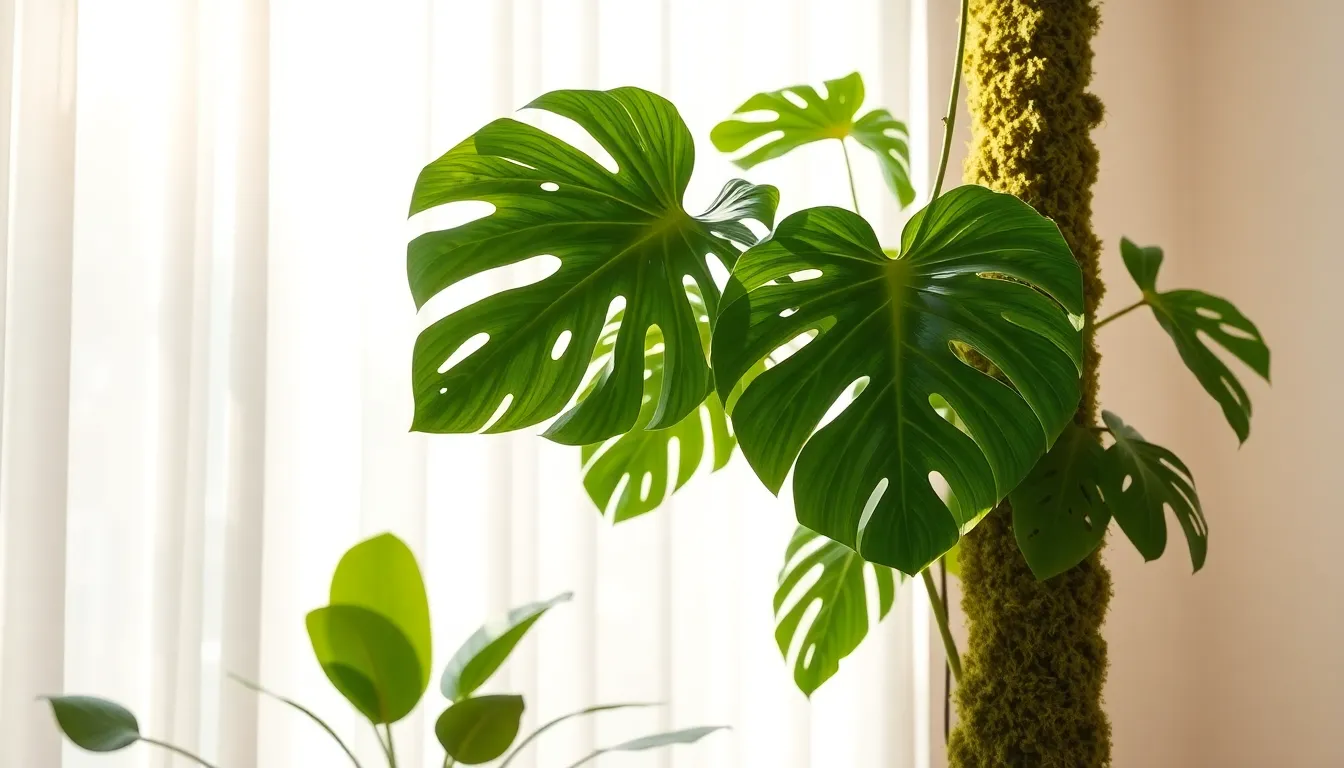
Monstera Deliciosa brings dramatic tropical flair to our indoor spaces while tolerating filtered light conditions better than many statement plants. We’ll find this Swiss cheese plant creates stunning visual impact with its fenestrated leaves and climbing nature.
Understanding Fenestration Development
Fenestration refers to the natural holes and splits that develop in mature Monstera leaves as the plant ages. Young plants typically produce solid heart-shaped leaves without any perforations during their first year of growth. We observe the first small holes appearing when plants reach 2-3 feet in height or around 18-24 months of age.
Light levels directly influence how quickly fenestration develops in our Monstera plants. Filtered bright light encourages faster fenestration compared to low light conditions where the process slows significantly. Plants receiving adequate filtered sunlight through sheer curtains or positioned near east-facing windows develop their characteristic splits more readily than those in darker corners.
Temperature consistency also affects fenestration timing since Monstera plants prefer temperatures between 65-80°F for optimal development. We notice that maintaining stable humidity levels around 50-60% helps promote healthy leaf development and encourages the formation of those coveted holes and splits.
Patience becomes essential when waiting for fenestration since rushing the process through excessive fertilization can actually delay proper leaf development. Mature plants in ideal filtered light conditions typically produce new fenestrated leaves every 4-6 weeks during the growing season.
Support Systems for Large Growth
Moss poles provide the most natural support system for our climbing Monstera plants since they mimic the tree bark these plants climb in their native habitat. We can create sturdy moss poles using sphagnum moss wrapped around wooden stakes or PVC pipes for long-lasting support structures.
Wooden trellises offer another excellent option for supporting large Monstera growth while adding architectural interest to our indoor spaces. Cedar or bamboo trellises work particularly well since they resist moisture damage and provide multiple attachment points for aerial roots.
Wall-mounted supports become necessary when our Monstera plants reach impressive sizes of 6-8 feet or more. Heavy-duty plant hooks anchored into wall studs can support substantial weight while allowing the plant to spread naturally across vertical surfaces.
Training techniques help us guide growth direction by gently securing vines to support structures using soft plant ties or velcro strips. We avoid wire ties that can cut into stems as the plant grows and expands over time.
Regular maintenance of support systems includes checking stability every few months and adjusting ties as stems thicken. Plants supported properly from early stages develop stronger root systems and more impressive fenestration patterns throughout their mature growth.
Spider Plant: Easy-Care Classic for Any Light Level
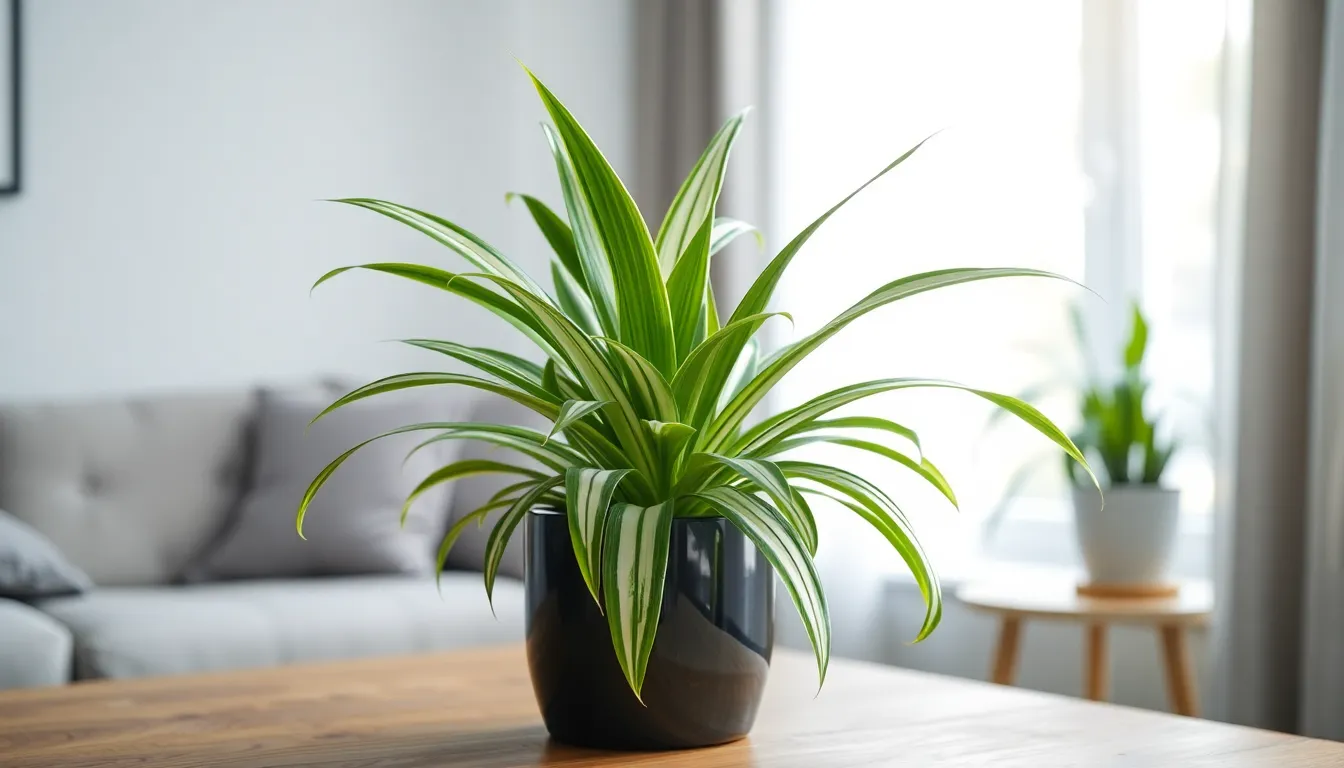
Spider plants stand out as one of the most forgiving indoor plants, adapting beautifully to various lighting conditions while adding tropical flair to any space. We’ve found these striped beauties to be perfect for beginners and experienced plant parents alike.
Propagating Spider Plant Babies
Spider plants make propagation incredibly simple through their distinctive plantlets, which develop along long stems called runners. We simply clip these baby plants once they’ve developed small roots and place them directly into moist potting soil. The plantlets can even be rooted while still attached to the mother plant by placing a small pot of soil beneath them.
Water propagation works equally well for spider plant babies. We place the plantlets in a glass of water and watch roots develop within 1-2 weeks. Fresh roots appear white and healthy, indicating the perfect time for transplanting into soil. Multiple babies can be propagated simultaneously, creating an entire collection from a single parent plant.
Division offers another reliable propagation method when the main plant becomes too large for its container. We carefully separate root clumps during repotting, ensuring each section has healthy roots and leaves. This technique rejuvenates older plants while creating new specimens for different rooms or gifting to friends.
Addressing Common Leaf Issues
Brown leaf tips frequently indicate sensitivity to fluoride or chlorine found in tap water, which we easily remedy by switching to distilled or filtered water. Low humidity can also cause brown tips, so we increase moisture levels by misting regularly or placing a humidity tray nearby. These simple adjustments typically resolve the issue within weeks.
Yellowing leaves usually signal overwatering, one of the most common mistakes with spider plants. We allow soil to dry slightly between waterings and check that containers have proper drainage holes. Reducing watering frequency often brings yellowing leaves back to their vibrant green color.
Spider mites and aphids occasionally target spider plants, appearing as tiny moving dots or sticky residue on leaves. We wipe leaves with a damp cloth weekly to prevent infestations and apply insecticidal soap when pests appear. Increasing humidity around the plant also deters spider mites, which prefer dry conditions.
Pale or faded leaf color typically indicates insufficient light, even though spider plants tolerate low light conditions. We move affected plants closer to windows or supplement with grow lights to restore their striking variegated patterns. Balanced fertilizer applied monthly during growing season also helps maintain vibrant foliage color.
Conclusion
Transforming your dim spaces into thriving green sanctuaries is entirely achievable with the right plant choices. We’ve explored many resilient species that not only survive but flourish in low-light conditions while adding natural beauty to your home.
From the nearly indestructible snake plant to the elegant peace lily these plants prove that limited sunlight doesn’t mean compromising on style or greenery. Each variety we’ve discussed offers unique benefits whether it’s air purification architectural appeal or easy propagation.
The key to success lies in understanding each plant’s exact needs and matching them to your space’s conditions. With proper care and patience you’ll discover that low-light gardening can be just as rewarding as any sun-drenched garden.
Start with one or two varieties that appeal to you most and watch as your confidence grows alongside your expanding indoor jungle.
Frequently Asked Questions
What are the best low-light houseplants for beginners?
Snake plants, ZZ plants, and pothos are excellent choices for beginners. These plants are extremely forgiving, require minimal watering, and can thrive in dim conditions. Snake plants and ZZ plants are particularly drought-tolerant, while pothos adapts well to various lighting conditions and is easy to propagate from cuttings.
How often should I water low-light houseplants?
Most low-light plants prefer infrequent watering. Snake plants and ZZ plants should be watered only when soil is completely dry, typically every 2-3 weeks. Peace lilies and pothos need slightly more frequent watering when the top inch of soil feels dry. Always check soil moisture before watering to prevent root rot.
Can houseplants really purify indoor air?
Yes, many low-light houseplants are proven air purifiers. Snake plants, ZZ plants, peace lilies, and philodendrons effectively remove common indoor toxins like formaldehyde and benzene. While they won’t replace proper ventilation, these plants can contribute to cleaner indoor air while adding natural beauty to your space.
Why are my plant’s leaves turning brown at the tips?
Brown leaf tips typically indicate overwatering, low humidity, or salt buildup from tap water. Check if soil is staying too wet, increase humidity with a pebble tray, and consider using filtered water. Dracaena plants are particularly sensitive to fluoride in tap water, which can cause brown tips.
How do I know if my low-light plant needs more light?
Signs include leggy growth, smaller leaves, loss of variegation in colorful plants, and overall weak appearance. While these plants tolerate low light, they may benefit from brighter indirect light. Avoid direct sunlight, which can scorch leaves. Consider moving plants closer to windows or using grow lights.
What’s the difference between climbing and non-climbing philodendrons?
Climbing philodendrons, like Heartleaf varieties, naturally trail or climb with support structures. They can be trained on moss poles or allowed to cascade from hanging baskets. Non-climbing types, such as ‘Brasil’ and ‘Moonlight,’ maintain compact, upright growth patterns and don’t require support systems.
How do I propagate my houseplants?
Most low-light plants are easy to propagate. Pothos and philodendrons root readily in water from stem cuttings. ZZ plants can be propagated through division or leaf cuttings. Spider plants produce natural plantlets that can be rooted. Snake plants can be divided or grown from leaf cuttings in soil.
When will my Monstera develop holes in its leaves?
Fenestration (natural holes) typically develops as Monstera plants mature, usually after 2-3 years with proper care. Factors like adequate light, consistent temperature, and climbing support encourage fenestration. Young plants start with solid heart-shaped leaves, gradually developing splits and holes as they grow larger and more established.
Can I grow plants in my basement apartment?
Yes, many plants adapt well to basement conditions. Snake plants, ZZ plants, and cast iron plants are particularly resilient in low natural light. Ensure adequate air circulation and consider supplementing with grow lights. Avoid overwatering in these typically more humid environments to prevent fungal issues.
How do I increase humidity for my houseplants?
Create humidity through pebble trays filled with water, grouping plants together, or placing plants in naturally humid areas like bathrooms. Avoid misting leaves directly, as this can promote fungal growth. Peace lilies and Chinese evergreens particularly benefit from higher humidity levels for optimal growth and flowering.

